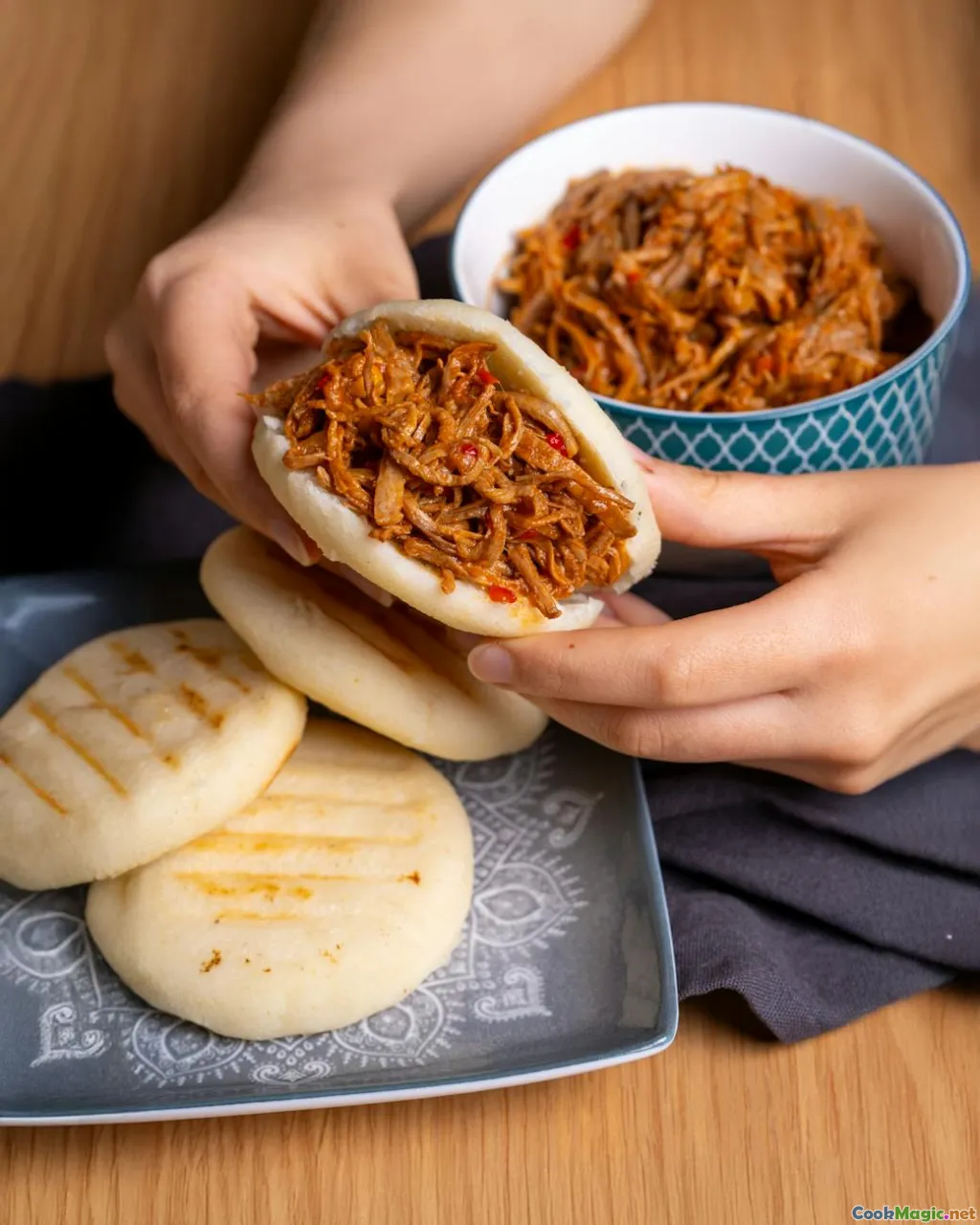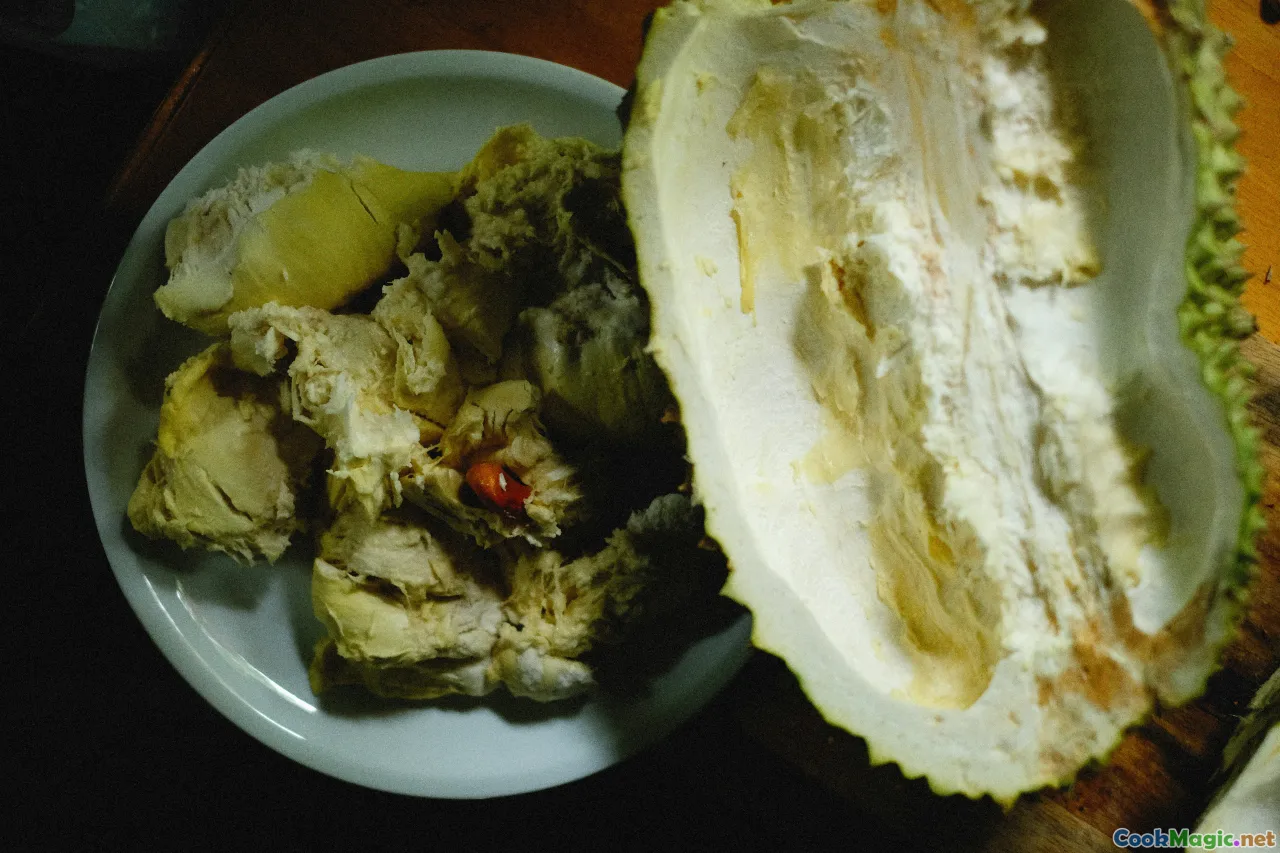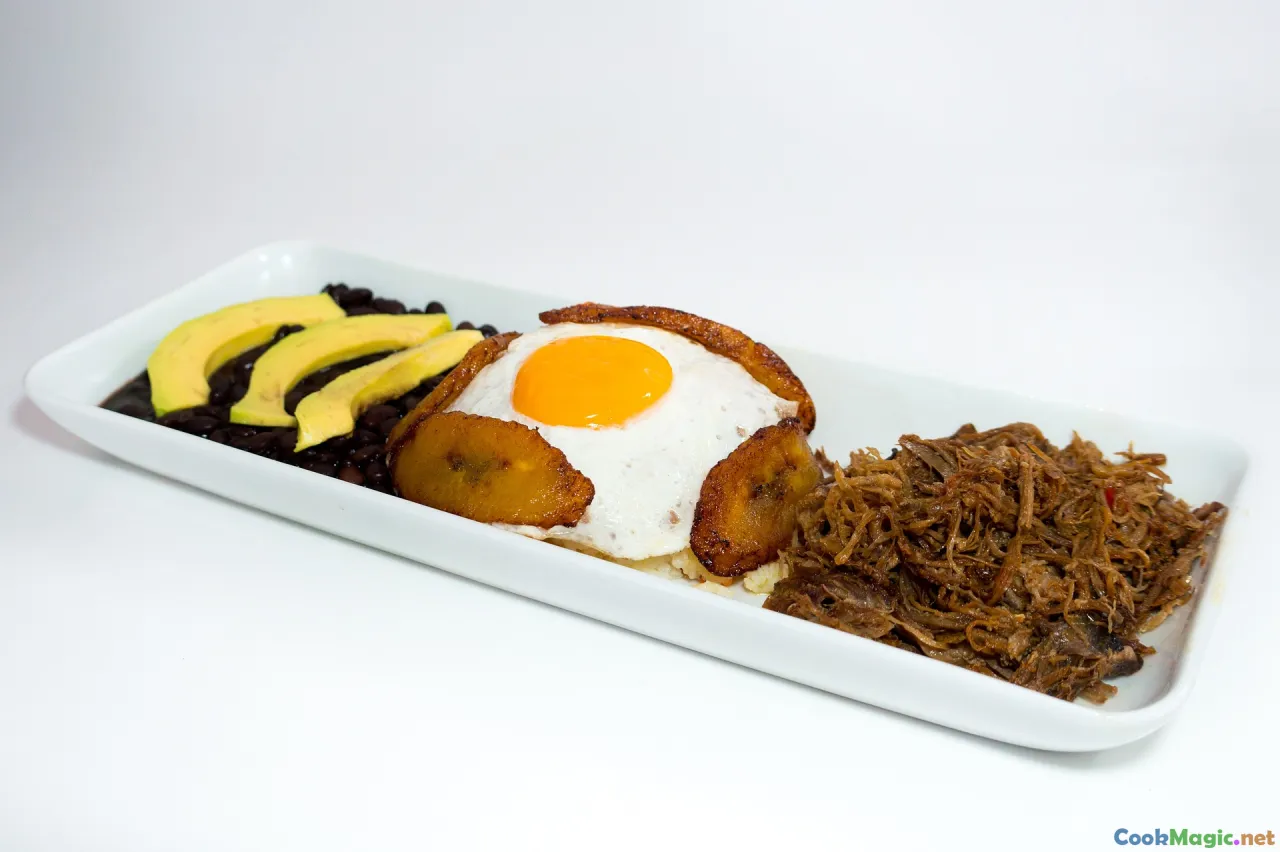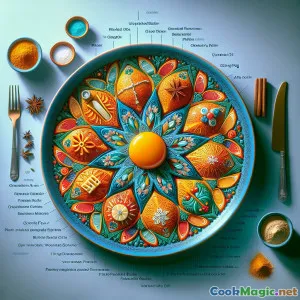
Ocumare 风格 Bollos Pelones,配有丰富番茄酱
(Ocumare-Style Bollos Pelones with Rich Tomato Sauce)
(0 评论)食材
-
400 grams 预煮白玉米粉(Harina P.A.N.)
(White or yellow; Venezuelan precooked maize flour)
-
600 ml 温水
(Add gradually until dough is soft, not sticky)
-
10 grams 细盐
(Split between dough, filling, and sauce)
-
15 ml 安纳托油(achiote)
(Gives the dough a golden hue; olive oil works)
-
500 grams 牛肩肉(绞碎或切成细碎)
(15–20% fat for juiciness)
-
150 grams 洋葱
(切成细丁)
-
100 grams 红甜椒
(Finely diced for sweetness and color)
-
4 cloves 大蒜
(剁碎的)
-
2 tbsp 番茄酱
(Adds depth and body)
-
200 grams 碎番茄
(Fresh or canned for the filling)
-
1 tsp 磨碎的孜然
(Classic Venezuelan seasoning)
-
1 tsp 干牛至
(Herbal aroma)
-
1 leaf 月桂叶
(Simmer with filling and discard)
-
50 grams 去核并切片的青橄榄
(Briny contrast)
-
1 tbsp 刺山柑
(Rinsed; boosts savoriness)
-
1 tbsp 苹果醋
(Balances richness)
-
1 tsp 糖
(Balances acidity in filling)
-
1/2 tsp 黑胡椒
(新鲜磨碎)
-
30 ml 中性油
(For sautéing the filling)
-
2 tbsp 新鲜香菜
(Chopped; stir into filling off heat)
-
30 ml 中性油或胭脂树籽油
(For the sauce base)
-
100 grams 洋葱
(Diced for the sauce)
-
3 cloves 大蒜
(Minced for the sauce)
-
400 grams 碎番茄
(1 standard can for the sauce)
-
250 ml 鸡肉或牛肉高汤
(Or water plus bouillon)
-
1 tsp 糖
(Balances tomato acidity)
-
1 tsp 盐
(根据口味调整)
-
1/2 tsp 黑胡椒
(根据个人口味)
-
14 grams 黄油
(Finishes sauce with gloss)
-
80 grams 白干酪(或温和的菲达奶酪),碎屑状
(Traditional garnish)
-
2 stalks 葱
(Thinly sliced for freshness)
-
4 wedges 青柠檬楔
(Optional squeeze at the table)
(White or yellow; Venezuelan precooked maize flour)
(Add gradually until dough is soft, not sticky)
(Split between dough, filling, and sauce)
(Gives the dough a golden hue; olive oil works)
(15–20% fat for juiciness)
(切成细丁)
(Finely diced for sweetness and color)
(剁碎的)
(Adds depth and body)
(Fresh or canned for the filling)
(Classic Venezuelan seasoning)
(Herbal aroma)
(Simmer with filling and discard)
(Briny contrast)
(Rinsed; boosts savoriness)
(Balances richness)
(Balances acidity in filling)
(新鲜磨碎)
(For sautéing the filling)
(Chopped; stir into filling off heat)
(For the sauce base)
(Diced for the sauce)
(Minced for the sauce)
(1 standard can for the sauce)
(Or water plus bouillon)
(Balances tomato acidity)
(根据口味调整)
(根据个人口味)
(Finishes sauce with gloss)
(Traditional garnish)
(Thinly sliced for freshness)
(Optional squeeze at the table)
营养
- 份量: 6
- 每份大小: 2 dumplings (260g)
- Calories: 620 kcal
- Carbohydrates: 0 g
- Protein: 29 g
- Fat: 28 g
- Fiber: 6 g
- Sugar: 6 g
- Sodium: 700 mg
- Cholesterol: 85 mg
- Calcium: 180 mg
- Iron: 3 mg
制作步骤
-
1 - Prep the Aromatics:
Finely dice onions and bell pepper. Mince garlic. Measure spices. Set aside half the onions and garlic for the sauce so each component cooks at its own pace.
-
2 - Brown the Beef:
Heat neutral oil in a wide skillet over medium-high. Add beef and cook, breaking it up, until lightly browned and no longer pink. Season with a pinch of salt and pepper.
-
3 - Build the Filling:
Stir in onions, bell pepper, and half the garlic. Cook until soft and fragrant. Add cumin, oregano, and tomato paste; cook 1 minute to caramelize. Add crushed tomatoes, olives, capers, vinegar, sugar, bay leaf, and 60 ml water.
-
4 - Simmer and finish filling:
Reduce heat and simmer until thick and jammy, not watery. Remove bay leaf. Stir in chopped cilantro. Taste and adjust salt, pepper, or acidity. Cool to room temperature.
-
5 - Start the Ocumare sauce:
In a saucepan, warm neutral or annatto oil over medium heat. Add reserved onions and remaining garlic; sweat until translucent. Stir in crushed tomatoes and broth.
-
6 - Season and reduce sauce:
Add sugar, salt, and pepper. Simmer 8–10 minutes until slightly thick. Whisk in butter off heat for a silky finish. Keep warm on low.
-
7 - Make the corn dough:
In a large bowl, whisk cornmeal and 1 tsp salt. Pour in warm water and annatto oil. Mix with fingers until a soft, smooth masa forms. If dry, add water by tablespoons.
-
8 - Rest the masa:
Let the dough rest covered to fully hydrate. Meanwhile, set a large pot of lightly salted water to a gentle simmer—barely bubbling to prevent cracking.
-
9 - Shape the pelones:
Divide dough into 12 portions. With wet hands, flatten one piece into a 9–10 cm disk. Add 1–2 tbsp cooled beef in the center. Cup and seal edges, rolling gently to form a smooth ball. Repeat, keeping balls covered.
-
10 - Poach the dumplings:
Slide balls into barely simmering water in batches. Cook 12–15 minutes until they float and feel bouncy-firm. Remove with a slotted spoon and drain briefly.
-
11 - Sauce and garnish:
Spoon tomato sauce onto plates. Nestle two dumplings per serving, ladle more sauce over, and top with crumbled queso blanco and sliced scallions. Optional squeeze of lime.
-
12 - Serve and store:
Serve hot. Refrigerate leftovers up to 3 days; reheat by steaming or gently simmering in sauce. Freeze shaped, uncooked dumplings for up to 2 months.
Finely dice onions and bell pepper. Mince garlic. Measure spices. Set aside half the onions and garlic for the sauce so each component cooks at its own pace.
Heat neutral oil in a wide skillet over medium-high. Add beef and cook, breaking it up, until lightly browned and no longer pink. Season with a pinch of salt and pepper.
Stir in onions, bell pepper, and half the garlic. Cook until soft and fragrant. Add cumin, oregano, and tomato paste; cook 1 minute to caramelize. Add crushed tomatoes, olives, capers, vinegar, sugar, bay leaf, and 60 ml water.
Reduce heat and simmer until thick and jammy, not watery. Remove bay leaf. Stir in chopped cilantro. Taste and adjust salt, pepper, or acidity. Cool to room temperature.
In a saucepan, warm neutral or annatto oil over medium heat. Add reserved onions and remaining garlic; sweat until translucent. Stir in crushed tomatoes and broth.
Add sugar, salt, and pepper. Simmer 8–10 minutes until slightly thick. Whisk in butter off heat for a silky finish. Keep warm on low.
In a large bowl, whisk cornmeal and 1 tsp salt. Pour in warm water and annatto oil. Mix with fingers until a soft, smooth masa forms. If dry, add water by tablespoons.
Let the dough rest covered to fully hydrate. Meanwhile, set a large pot of lightly salted water to a gentle simmer—barely bubbling to prevent cracking.
Divide dough into 12 portions. With wet hands, flatten one piece into a 9–10 cm disk. Add 1–2 tbsp cooled beef in the center. Cup and seal edges, rolling gently to form a smooth ball. Repeat, keeping balls covered.
Slide balls into barely simmering water in batches. Cook 12–15 minutes until they float and feel bouncy-firm. Remove with a slotted spoon and drain briefly.
Spoon tomato sauce onto plates. Nestle two dumplings per serving, ladle more sauce over, and top with crumbled queso blanco and sliced scallions. Optional squeeze of lime.
Serve hot. Refrigerate leftovers up to 3 days; reheat by steaming or gently simmering in sauce. Freeze shaped, uncooked dumplings for up to 2 months.
关于 Ocumare 风格 Bollos Pelones,配有丰富番茄酱 :的更多信息
About Bollos Pelones de Ocumare
Bollos pelones are Venezuela’s tender, comforting cornmeal dumplings—“pelones” (bald) because they’re cooked without a leaf wrapper. The Ocumare style, associated with the coastal town of Ocumare de la Costa, leans bright and saucy: a silky tomato base scented with annatto, ladled generously over corn dumplings stuffed with savory beef. It’s everyday food elevated by careful technique, and a dish that brings families to the table on weekends and celebrations alike.
What Makes the Ocumare Style Special
- Achiote hue: Annatto oil lightly tints the dough and sauce, echoing coastal cooks who favor vibrant color and gentle nuttiness.
- Briny pops: Green olives and capers in the beef filling nod to classic Venezuelan guiso, adding depth and contrast to the sweet corn dough.
- Poached, not fried: The dumplings are gently simmered in water so the exterior stays smooth and the interior remains soft and plush.
Technique Tips for Perfect Pelones
- Hydration matters: Precooked Venezuelan cornmeal (harina P.A.N.) hydrates quickly. Mix until the dough feels like soft earthen clay—supple and barely tacky. If it cracks when you press an edge, add a teaspoon of warm water and re-knead.
- Rest the dough: A 5–10 minute rest fully hydrates the cornmeal, preventing micro-cracks that could cause leaks during poaching.
- Cool the filling: Warm filling can steam inside the dumpling and split the seam. Let the beef mixture cool until just lukewarm before shaping.
- Gentle simmer: Keep the water just under a boil; aggressive bubbling can rough up the surface or open seams. A calm bath yields the signature “bald” smoothness.
- Seal well: Work with damp hands. Press out air pockets around the filling and pinch the seam firmly before rolling into a sphere.
Ingredient Notes and Smart Swaps
- Cornmeal: Use Venezuelan-style precooked cornmeal. Mexican masa harina behaves differently; if using it, expect a firmer texture and adjust hydration.
- Protein: Swap beef for shredded chicken, turkey, or a plant-based crumble. In coastal spirit, Ocumare cooks sometimes use salted fish or tuna for a briny twist.
- Aromatics: Bell pepper adds sweetness and color; skip it if you prefer a cleaner profile or replace with ají dulce if available.
- Cheese: Queso blanco provides milky salinity. A mild feta is acceptable in a pinch; rinse briefly if very salty.
- Annatto oil: Infuses color and a whisper of flavor. If unavailable, olive oil works—add a pinch of sweet paprika for hue.
Serving Ideas
- Pair with crisp salads (tomato, cucumber, onion) or pan-fried ripe plantains for sweetness.
- A cold papelón con limón (panela lemonade) or a light lager complements the richness.
- Garnish variations: Fresh cilantro, parsley, or chives brighten the plate.
Make-Ahead and Freezing
- Filling and sauce: Make up to 3 days ahead. Flavors meld beautifully overnight.
- Shaped dumplings: Freeze on a tray, then bag for up to 2 months. Cook from frozen, adding a few extra minutes.
- Leftovers: Reheat gently in sauce or by steaming. Microwaving works if you splash with water and cover to keep them moist.
Cultural Footnote
Bollos pelones crisscross Venezuela—from the central valleys to coastal towns—each region adjusting spices, fillings, and sauces to local tastes. In Ocumare, you’ll meet colors and aromas shaped by the sea’s trade routes: olives, capers, and annatto weaving into the corn-and-tomato canvas. It’s a bowl that tells a story of migrations, markets, and Sunday kitchens. Sharing pelones is as much about nourishment as it is about gathering—people leaning over pots, tasting, laughing, and passing down knowledge by touch and memory.
Troubleshooting
- Dumplings cracking: Dough too dry or water too turbulent. Add a touch more warm water to the dough and lower the simmer.
- Filling seeping out: Filling was too wet or too hot. Reduce the filling until thick and cool it before shaping.
- Sauce too tart: A pinch of sugar and an extra minute of simmering smooths the edges.
Personal Notes
I love how these dumplings reward patience. The tactile rhythm—mixing masa, rolling smooth orbs, listening for the quiet bob as they cook—turns cooking into a calm ritual. The first spoon of bright sauce over the glistening pelón always feels like a celebration. If you’re new to Venezuelan cuisine, this is a welcoming gateway: humble, hearty, and brimming with character.


















